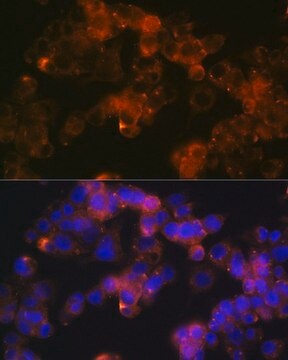S8321
Monoclonal Anti-Sonic Hedgehog (Shh) antibody produced in mouse
clone SH154, purified from hybridoma cell culture
Sinónimos:
Anti-Shh
About This Item
Productos recomendados
origen biológico
mouse
conjugado
unconjugated
forma del anticuerpo
purified immunoglobulin
tipo de anticuerpo
primary antibodies
clon
SH154, monoclonal
formulario
buffered aqueous solution
reactividad de especies
human, rat, mouse
concentración
~2 mg/mL
técnicas
immunohistochemistry: 1:500 using formaldehyde-fixed human tissue sections
indirect ELISA: 2 μg/mL
western blot: 2 μg/mL using recombinant mouse SHH peptide
isotipo
IgG1
Nº de acceso UniProt
Condiciones de envío
dry ice
temp. de almacenamiento
−20°C
modificación del objetivo postraduccional
unmodified
Información sobre el gen
human ... SHH(6469)
mouse ... Shh(20423)
rat ... Shh(29499)
Descripción general
Anti-Sonic Hedgehog antibody recognizes human, rat and mouse Shh.
Especificidad
Aplicación
Acciones bioquímicas o fisiológicas
Forma física
Cláusula de descargo de responsabilidad
¿No encuentra el producto adecuado?
Pruebe nuestro Herramienta de selección de productos.
Producto relacionado
Código de clase de almacenamiento
10 - Combustible liquids
Clase de riesgo para el agua (WGK)
WGK 3
Punto de inflamabilidad (°F)
Not applicable
Punto de inflamabilidad (°C)
Not applicable
Equipo de protección personal
Eyeshields, Gloves, multi-purpose combination respirator cartridge (US)
Certificados de análisis (COA)
Busque Certificados de análisis (COA) introduciendo el número de lote del producto. Los números de lote se encuentran en la etiqueta del producto después de las palabras «Lot» o «Batch»
¿Ya tiene este producto?
Encuentre la documentación para los productos que ha comprado recientemente en la Biblioteca de documentos.
Artículos
Cancer stem cell media, spheroid plates and cancer stem cell markers to culture and characterize CSC populations.
Nuestro equipo de científicos tiene experiencia en todas las áreas de investigación: Ciencias de la vida, Ciencia de los materiales, Síntesis química, Cromatografía, Analítica y muchas otras.
Póngase en contacto con el Servicio técnico






